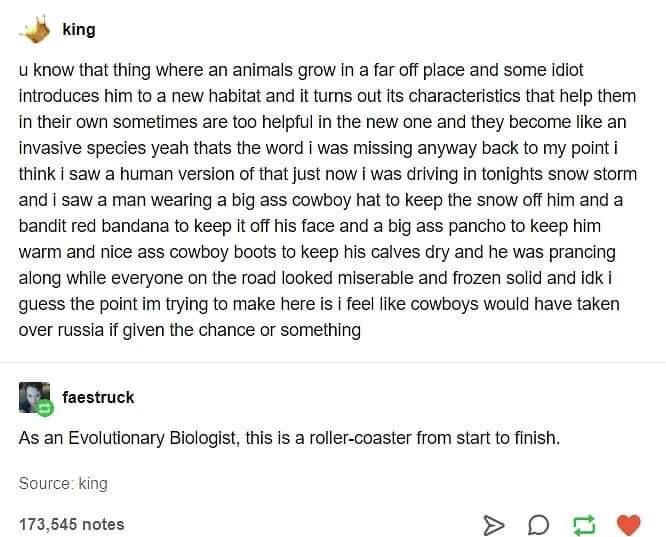this post was submitted on 25 Feb 2024
745 points (98.4% liked)
Science Memes
16874 readers
1616 users here now
Welcome to c/science_memes @ Mander.xyz!
A place for majestic STEMLORD peacocking, as well as memes about the realities of working in a lab.

Rules
- Don't throw mud. Behave like an intellectual and remember the human.
- Keep it rooted (on topic).
- No spam.
- Infographics welcome, get schooled.
This is a science community. We use the Dawkins definition of meme.
Research Committee
Other Mander Communities
Science and Research
Biology and Life Sciences
- !abiogenesis@mander.xyz
- !animal-behavior@mander.xyz
- !anthropology@mander.xyz
- !arachnology@mander.xyz
- !balconygardening@slrpnk.net
- !biodiversity@mander.xyz
- !biology@mander.xyz
- !biophysics@mander.xyz
- !botany@mander.xyz
- !ecology@mander.xyz
- !entomology@mander.xyz
- !fermentation@mander.xyz
- !herpetology@mander.xyz
- !houseplants@mander.xyz
- !medicine@mander.xyz
- !microscopy@mander.xyz
- !mycology@mander.xyz
- !nudibranchs@mander.xyz
- !nutrition@mander.xyz
- !palaeoecology@mander.xyz
- !palaeontology@mander.xyz
- !photosynthesis@mander.xyz
- !plantid@mander.xyz
- !plants@mander.xyz
- !reptiles and amphibians@mander.xyz
Physical Sciences
- !astronomy@mander.xyz
- !chemistry@mander.xyz
- !earthscience@mander.xyz
- !geography@mander.xyz
- !geospatial@mander.xyz
- !nuclear@mander.xyz
- !physics@mander.xyz
- !quantum-computing@mander.xyz
- !spectroscopy@mander.xyz
Humanities and Social Sciences
Practical and Applied Sciences
- !exercise-and sports-science@mander.xyz
- !gardening@mander.xyz
- !self sufficiency@mander.xyz
- !soilscience@slrpnk.net
- !terrariums@mander.xyz
- !timelapse@mander.xyz
Memes
Miscellaneous
founded 2 years ago
MODERATORS
you are viewing a single comment's thread
view the rest of the comments
view the rest of the comments

And according to this person being dressed up for the cold is wearing clothes that are designed to be worn in warm weather. Dumb.
Cowboy gear was outdoor working gear, this is completely believable if the guy was in actual work clothes.
Y'all just city af.
What makes it dumb is that the clothing described wouldn't have been what kept them warm and unfazed, that would be the layers underneath the made up cowboy's attire.
What makes it silly is that cowboys exist across the very snowy north and have since cowboys have existed anywhere.
A cowboy hat, banana, a duster, and boots is how i understood the description which is warm weather garb.
You're just too city to understand that.
Bro never heard about long johns and thinks dusters are exclusively warm weather gear 💀
(Also the description specifically mentions a poncho, not a duster, but ponchos are also useful for cold weather)
Ah yes, the classic winter garb: a ~~duster~~ poncho and a cowboy hat. Lmao
Not American but doesn't central America get cold as fuck at night? I would assume that's what cowboys dressed for since you can always remove clothes but you can't exactly create them from thin air at night.
I'm not an expert, but I believe it's more of a North American thing (Canada, U.S.A., Mexico) due to the mountain systems along the three countries. The Rocky Mountains, the Trans-Mexican Volcanic Velt, etc. are all part of the North American Cordillera. This, and the occasional deserts.
I'd guess ponchos, jorongos, and similar pieces of clothing were adopted by non-native settlers (Spanish, English, etc.), including non-native cowboys, because they are good against the changing weather during the day and the cold nights, as you said.
I mean, Central America must have cold spots along their own mountains and South America has the Andean Mountain Range (enormous system), but I do not know about their traditional clothing, except they share the poncho, and I do not know which of their clothing we still wear to this day.